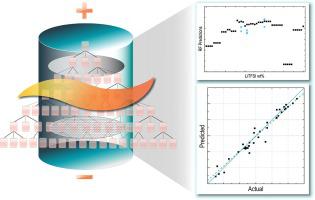当前位置:
X-MOL 学术
›
Comp. Mater. Sci.
›
论文详情
Our official English website, www.x-mol.net, welcomes your
feedback! (Note: you will need to create a separate account there.)
A data science approach for advanced solid polymer electrolyte design
Computational Materials Science ( IF 3.1 ) Pub Date : 2021-02-01 , DOI: 10.1016/j.commatsci.2020.110108 Marianne Liu , Conrad Clement , Kathy Liu , Xuming Wang , Taylor D. Sparks
Computational Materials Science ( IF 3.1 ) Pub Date : 2021-02-01 , DOI: 10.1016/j.commatsci.2020.110108 Marianne Liu , Conrad Clement , Kathy Liu , Xuming Wang , Taylor D. Sparks

|
Abstract Solid polymer electrolytes (SPEs) stand to revolutionize battery technology innovation by making batteries non-flammable, flexible, and more sustainable. However, SPE breakthroughs are limited by the highly time and resource-intensive nature of battery research. Even when suitable materials are discovered, optimizing the composition and experimental conditions presents another critical barrier to SPE realization. In this work, a data-driven approach to SPE development is presented. First, data is collected and analyzed from published literature, and then supplemented with independent experimentation to complete the SPE dataset. Then, six different models (linear regression, lasso regression, ridge regression, decision tree, random forest, and radial basis function SVM) were tested. The random forest model is identified as the most suitable model with the greatest predictive capability, validated by independent experimentation and by comparing predicted activation energies to those reported in literature using raw predictions from the model. The random forest model is calculated to predict conductivity with a root-mean-square-error of 0.332 log(S/cm). By applying machine learning to incorporate important parameters of SPE synthesis, this study provides a foundation for accelerated SPE innovation.
中文翻译:

用于高级固体聚合物电解质设计的数据科学方法
摘要 固体聚合物电解质 (SPEs) 通过使电池不易燃、灵活且更具可持续性,将彻底改变电池技术创新。然而,SPE 的突破受到电池研究的高度时间和资源密集性的限制。即使发现了合适的材料,优化成分和实验条件也是实现 SPE 的另一个关键障碍。在这项工作中,提出了一种数据驱动的 SPE 开发方法。首先,从已发表的文献中收集和分析数据,然后辅以独立实验以完成 SPE 数据集。然后,测试了六种不同的模型(线性回归、套索回归、岭回归、决策树、随机森林和径向基函数 SVM)。随机森林模型被确定为最合适的具有最大预测能力的模型,通过独立实验验证,并通过使用模型的原始预测将预测的激活能与文献中报告的那些进行比较。计算随机森林模型以预测电导率,均方根误差为 0.332 log(S/cm)。通过应用机器学习来整合 SPE 合成的重要参数,本研究为加速 SPE 创新奠定了基础。
更新日期:2021-02-01
中文翻译:

用于高级固体聚合物电解质设计的数据科学方法
摘要 固体聚合物电解质 (SPEs) 通过使电池不易燃、灵活且更具可持续性,将彻底改变电池技术创新。然而,SPE 的突破受到电池研究的高度时间和资源密集性的限制。即使发现了合适的材料,优化成分和实验条件也是实现 SPE 的另一个关键障碍。在这项工作中,提出了一种数据驱动的 SPE 开发方法。首先,从已发表的文献中收集和分析数据,然后辅以独立实验以完成 SPE 数据集。然后,测试了六种不同的模型(线性回归、套索回归、岭回归、决策树、随机森林和径向基函数 SVM)。随机森林模型被确定为最合适的具有最大预测能力的模型,通过独立实验验证,并通过使用模型的原始预测将预测的激活能与文献中报告的那些进行比较。计算随机森林模型以预测电导率,均方根误差为 0.332 log(S/cm)。通过应用机器学习来整合 SPE 合成的重要参数,本研究为加速 SPE 创新奠定了基础。











































 京公网安备 11010802027423号
京公网安备 11010802027423号